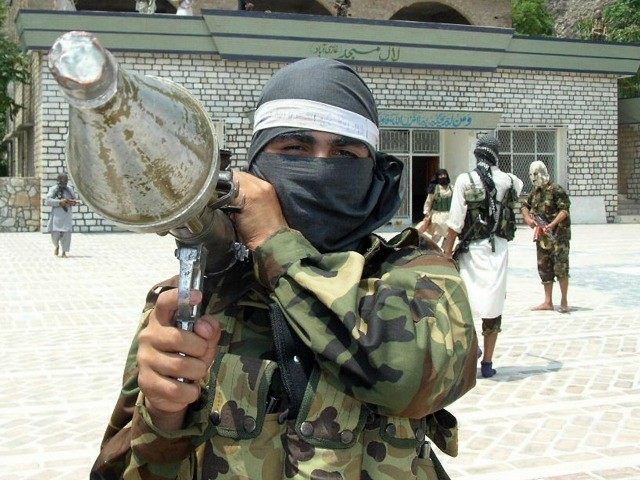The Obama administration is reportedly using U.S. taxpayer funds to support an Afghan government program providing financial and military aid to a Taliban splinter faction, one allegedly linked to the growing Islamic State (ISIS/ISIL) in Afghanistan.
“It’s a very complex war,” a Kabul-based Afghan intelligence agency official familiar with the program, told the Wall Street Journal (WSJ). “Sometimes you need to be on every side.”
“It’s a game. The tactics of war: Sometimes a friend, and sometimes a foe,” added a senior Afghan Special Forces battalion commander who has been involved in providing support to the splinter Taliban group. “We are military people. We execute orders.”
WSJ described a key component of the effort as preventing “disgruntled” Taliban leaders from defecting to ISIS in Afghanistan.
Citing Afghan and U.S. coalition officials, after a U.S. airstrike inside Pakistan reportedly killed core Taliban leader Mullah Akhtar Mansour, WSJ reports, “The Afghan government is giving financial and military support to a breakaway Taliban faction… in an effort to sow rifts within the insurgency and nudge some of its leaders toward peace talks.”
“Senior Afghan and U.S. diplomatic, military and intelligence officials, including several who had roles in creating the program, described its details and said that resources provided by the U.S. were used to support it,” it adds.
Since the war in Afghanistan started in October 2001, the U.S. government has appropriated more than $113 billion for nation-building efforts in the country, most (nearly $70 billion) of which has been devoted to security efforts.
WSJ quotes unnamed Afghan and U.S. officials as saying Afghanistan’s intelligence agency, the National Directorate of Security (NDS), is leading the program to support breakaway Taliban groups.
“The agency relies on the U.S. for most of its funding and is still mentored by the Central Intelligence Agency. The CIA declined to comment for this article,” acknowledges the Journal.
Anonymous U.S. and Afghan security officials told WSJ that “the program carries significant risks. Recruited Taliban commanders, who have yet to commit to peace talks with the government, may turn against Afghan and foreign forces in the country with the ammunition supplied to them.”
The effort has largely failed to stem the Taliban’s increasingly deadly insurgency, notes the Journal.
Although the report suggests there are multiple “fractious Taliban groups” receiving cash and military equipment from the Afghan government, primarily funded by U.S. taxpayers through the CIA, only one is named. That group is led by a commander named Mullah Mohammad Rasool.
It emerged after the terrorist group’s longtime chief, Mullah Mohammad Omar, was declared to have been dead for years, a revelation that caused infighting within the Taliban that potentially benefited ISIS in Afghanistan.
Various Taliban commanders left the group and joined ISIS as a result of Mullah Mansour’s appointment to serve as the leader of the Taliban.
In late 2015, fighters loyal to Rasool clashed with those led by the appointed Taliban leader Mansour in Zabul, a southern Afghan province along the Pakistan border. Zabul lies next to Kandahar province, known as the birthplace of the Taliban.
Al Jazeera quoted Anwar Ishaqzai, governor of southern Zabul province, at the time as saying, “The Taliban faction under Mullah Rasool was backed by the ISIL and Uzbek fighters in the fight.”
However, a spokesman for the breakaway group denied the allegations.
“We will never join them. Their ideologies are different; they come from a different background and a different history,” Abdul Manan Niazi, told Al Jazeera.
“These are all false accusations. We can never ask for their support to fight our enemies or to re-establish Islamic rule,” he added.
Rasool’s group has also denied receiving American-backed support from Kabul to fight the rival Taliban faction.
“We do not receive any assistance from the government and we have no relationship with them,” Maulvi Ghulam Mohammad Hotak, a commander under Mullah Rasool, told WSJ.
The U.S.-backed administration of Afghan President Ashraf Ghani has also denied having links to any Taliban group.
“The Afghan government does not support any Taliban groups and we categorically reject such claims as baseless,” Sayed Zafar Hashemi, a spokesman for Ghani, told the Journal.
Moreover, an unnamed spokesman for the U.S-led coalition denied that the alliance was ” directly or indirectly” lending support to any members of the breakaway faction.
Nevertheless, WSJ quotes various unnamed U.S. coalition and Afghan officials as providing a different story.
Along with Mohammad Haji Amir Karimi, a local militia commander who joined Rasool’s group after it was allegedly rescued from a battle with the Taliban by Afghan Special Forces, U.S. and Afghan officials claim the Afghan government has indeed provided assistance to the splinter group.

COMMENTS
Please let us know if you're having issues with commenting.